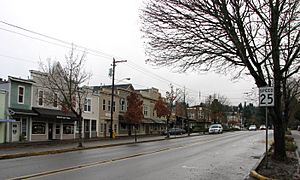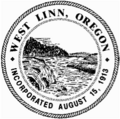West Linn, Oregon facts for kids
Quick facts for kids
West Linn
|
|||
|---|---|---|---|
|
City
|
|||
| West Linn, Oregon | |||
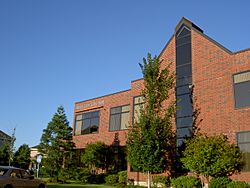
West Linn City Hall
|
|||
|
|||
| Motto(s):
City of Hills, Trees and Rivers
|
|||
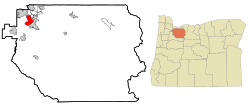
Location in Oregon
|
|||
| Country | United States | ||
| State | Oregon | ||
| County | Clackamas | ||
| Incorporated | 1913 | ||
| Named for | Lewis F. Linn | ||
| Government | |||
| • Type | Mayor–council government | ||
| Area | |||
| • Total | 8.11 sq mi (21.00 km2) | ||
| • Land | 7.43 sq mi (19.24 km2) | ||
| • Water | 0.68 sq mi (1.76 km2) | ||
| Elevation | 679 ft (207 m) | ||
| Population
(2020)
|
|||
| • Total | 27,373 | ||
| • Density | 3,684.12/sq mi (1,422.47/km2) | ||
| Time zone | UTC-8 (Pacific) | ||
| • Summer (DST) | UTC-7 (Pacific) | ||
| ZIP code |
97068
|
||
| Area code(s) | 503 and 971 | ||
| FIPS code | 41-80150 | ||
| GNIS feature ID | 2412224 | ||
| Website | westlinnoregon.gov | ||
West Linn is a city in Clackamas County, Oregon, United States. It is a southern suburb of the Portland metropolitan area. West Linn was built on the land of an older town called Linn City. This town was named after Lewis F. Linn, a U.S. Senator. He believed that the United States should claim the Oregon Territory.
In 1889, the Sullivan hydroelectric plant opened. It used energy from the nearby Willamette Falls. The Willamette Falls Pulp and Paper Company also started working that same year.
In 2020, about 27,373 people lived in West Linn.
Contents
History of West Linn
Before pioneers settled here, the area that became West Linn was home to ancestors of the Confederated Tribes of the Grand Ronde Community of Oregon.
Early Settlements in the 1800s
Major Robert Moore was an early settler who arrived in 1839. He was part of the first group that tried to create an American state in Oregon. Moore bought about 1,000 acres of land on the west side of Willamette Falls. This was across the Willamette River from Oregon City. He bought the land from Chief Wanaxha of the Wallamut Tribe.
In 1843, Moore planned a town on this land and called it "Robin's Nest." On December 22, 1845, the Oregon Territorial Legislature voted to rename it Linn City. This was to honor Senator Lewis F. Linn, who was a friend of the Moore family. Linn County is also named after him.
For many years, Linn City was a competitor to Oregon City. But it faced many challenges. A big fire and the Great Flood of 1862 stopped the pioneer settlement in 1861. Many families had to move to other parts of the Pacific Northwest.
The Willamette Falls Locks and canal were finished in 1873. This made it possible for boats to travel past the waterfall. The locks closed in 2011 and have not reopened. The Willamette Falls Pulp and Paper Company started its operations in 1889.
West Linn in the 1900s
West Linn officially became a city in 1913. It later joined with the nearby town of Willamette in 1916. Willamette had become a city five years earlier. When West Linn became a city, it included areas like West Oregon City, Bolton, Sunset, and Willamette Heights. Becoming a city helped these areas get important services like utilities. The city founders decided to name the new city "West Linn" to honor the pioneer town that Robert Moore had started.
The Oregon City Bridge was built in 1922.
The city's population grew steadily over the years. In 1860, there were 225 residents. By 1920, the number grew to 1,628. In 1960, the population was 2,923, and by 1970, it was over 7,000. The city's population has continued to grow.
West Linn in the 2000s
In 2011, West Linn was named the top-ranked Oregon city on CNN/Money Magazine's 'Best Places to Live' list. The magazine mentioned its "breathtaking views of the Cascades" and low local taxes. It also highlighted the Music in the Park concert series, the historic Willamette area, the farmer's market, and the Street Dance.
In 2012, West Linn was named a Tree City USA Community by the Arbor Day Foundation. This award recognizes the city's efforts to care for its urban forests. It was the 19th year West Linn received this honor. Trees provide many benefits, like shade for homes and beauty for neighborhoods. They also help the environment and the economy.
Geography and Nature
West Linn covers about 8.05 square miles (21.00 square kilometers). Most of this area is land, and a small part is water. The city is located between the Willamette and Tualatin rivers. It includes areas that used to be separate towns or developments, like Willamette, Bolton, and West Oregon City.
The Nature Conservancy protects the Camassia Natural Area in central West Linn. This 26-acre area is on a rocky plateau formed by ancient floods. It is named after the camas flowers that bloom there in spring. About 300 other plant species grow here, including the white rock larkspur, which is very rare. The area also has Oregon white oak and madrone trees, wet meadows, ponds, and temporary pools of water called vernal pools.
The Mary S. Young State Recreation Area is also in West Linn. It is located between Oregon Route 43 and the Willamette River. This park has a large off-leash dog area, soccer fields, and many miles of trails.
West Linn is also where the Willamette Meteorite was found. This large meteorite was moved to this area by ancient floods.
Climate in West Linn
West Linn has a range of temperatures. The coldest temperature ever recorded was -2°F (-19°C) in 1950. The hottest temperature was 107°F (42°C), recorded in 1956 and 1981.
| Climate data for West Linn, OR | |||||||||||||
|---|---|---|---|---|---|---|---|---|---|---|---|---|---|
| Month | Jan | Feb | Mar | Apr | May | Jun | Jul | Aug | Sep | Oct | Nov | Dec | Year |
| Record high °F (°C) | 66 (19) |
75 (24) |
81 (27) |
92 (33) |
104 (40) |
115 (46) |
107 (42) |
107 (42) |
105 (41) |
96 (36) |
73 (23) |
68 (20) |
107 (42) |
| Mean daily maximum °F (°C) | 49 (9) |
53 (12) |
58 (14) |
64 (18) |
70 (21) |
76 (24) |
83 (28) |
84 (29) |
78 (26) |
65 (18) |
53 (12) |
47 (8) |
65 (18) |
| Mean daily minimum °F (°C) | 37 (3) |
37 (3) |
40 (4) |
43 (6) |
48 (9) |
53 (12) |
56 (13) |
56 (13) |
52 (11) |
46 (8) |
40 (4) |
35 (2) |
45 (7) |
| Record low °F (°C) | −2 (−19) |
6 (−14) |
22 (−6) |
28 (−2) |
31 (−1) |
37 (3) |
41 (5) |
41 (5) |
33 (1) |
24 (−4) |
9 (−13) |
6 (−14) |
−2 (−19) |
| Average precipitation inches (mm) | 6.78 (172) |
4.78 (121) |
4.67 (119) |
3.47 (88) |
2.46 (62) |
1.74 (44) |
0.65 (17) |
0.72 (18) |
1.61 (41) |
3.61 (92) |
6.56 (167) |
7.32 (186) |
44.37 (1,127) |
People and Population
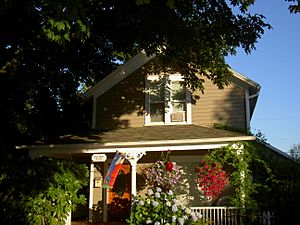
| Historical population | |||
|---|---|---|---|
| Census | Pop. | %± | |
| 1920 | 1,628 | — | |
| 1930 | 1,956 | 20.1% | |
| 1940 | 2,165 | 10.7% | |
| 1950 | 2,945 | 36.0% | |
| 1960 | 3,933 | 33.5% | |
| 1970 | 7,091 | 80.3% | |
| 1980 | 11,358 | 60.2% | |
| 1990 | 16,367 | 44.1% | |
| 2000 | 22,261 | 36.0% | |
| 2010 | 25,109 | 12.8% | |
| 2020 | 27,373 | 9.0% | |
| Sources: | |||
In 2010, there were 25,109 people living in West Linn. There were 9,523 households and 7,081 families. The city had about 3,398 people per square mile (1,312 per square kilometer).
Most of the people in West Linn were White (90.7%). There were also people of Asian (4.0%), African American (0.7%), and Native American (0.3%) backgrounds. About 4.0% of the population was Hispanic or Latino.
In 37.8% of households, there were children under 18. Most households (61.8%) were married couples living together. The average household had 2.62 people, and the average family had 3.04 people.
The average age of people in West Linn was 41.5 years old. About 26.3% of residents were under 18, and 11.1% were 65 or older.
Education in West Linn
Public schools in West Linn, including West Linn High School, are part of the West Linn-Wilsonville School District.
The city also has the West Linn Public Library. This library is part of the Library Information Network of Clackamas County.
Local Media
- West Linn Tidings is a local newspaper.
Notable People from West Linn
Many interesting people have lived in West Linn, including:
- Cooper Becklin, a racing driver.
- Steve Blake, a former professional basketball player.
- Gert Boyle, who was the chairwoman of Columbia Sportswear.
- Cole Gillespie, a baseball player.
- Michael Harper, a former basketball player for the Portland Trail Blazers.
- Darlene Hooley, a former United States Congresswoman.
- Nate McMillan, a former head coach for the Portland Trail Blazers.
- Cade McNown, a football player.
- Robert Moore, who founded Linn City.
- Payton Pritchard, a basketball player.
- Brandon Roy, a former basketball player for the Portland Trail Blazers.
- Chael Sonnen, a professional mixed martial artist.
- Mitch Williams, a baseball player.
- Monty Williams, a former NBA player and coach.
Images for kids
See also
 In Spanish: West Linn para niños
In Spanish: West Linn para niños




